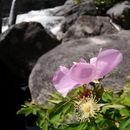en
names in breadcrumbs


Rosa nutkana, commonly known as the Nootka rose, is an angiosperm of the Rosaceae family. The flowers typically have five large petals, growing to about 2.5 cm long in varying in shades of pink (Knoke and Giblin 2017). These petals form a single layered corolla, which is usually accompanied by five thin, green sepals that are often nearly as long as the petals (USDA 2017.) The pistils and stamens in the center of the flower make up a golden yellow ring, with the stamens completely surrounding the pistils. Rosa nutkana are perennial plants that bloom in the summer, from May to July (Knoke and Giblin 2017).
Subspecies of the Rosa nutkana include Rosa nutkana subsp. melina, Rosa nutkana subsp. nutkana, Rosa nutkana subsp. macdougalii, and at least one other which lacks an official name (Flora of North America 2017). Most Rosa nutkana have thorns as a defense mechanism, and most subspecies have straight thorns or lack them, save one which has curved thorns. The plant takes the form of a shrub with thin, tangled, dark stems growing up to 2 meters in height (USDA 2017). Its leaves are bright green and pinnately compound (Alden 1998). Both the leaves and the hips, containing the seeds, are deciduous, and the fruit is ripe from August to September. The hips are particularly palatable for deer, elk, and squirrels (Reed 1993).
Native to the Pacific Northwest, Rosa nutkana resides at elevations below 2.3 km west of the Cascade Crest, along the Pacific Coast from Alaska to Northern California. It thrives in moderately wet climates, frequently occurring in floodplains, meadows, and streambanks (Reed 1993). It also tends to grow sporadically in open-canopy forests as an understory plant. Forest communities in which Rosa nutkana can be commonly found include: Douglas-fir, Ponderosa pine, Mountain hemlock, Sitka spruce, Lodgepole pine, Redwood, and estern hardwoods (Pavek and Skinner 2013). It can also be found growing near red osier dogwood, quaking aspen, black cottonwood, and snowberry (USDA 2017).
Rosa nutkana is generally an adaptable plant, and because of this, it is very abundant (Knoke and Giblin 2017). It can exist in a wide range of pH environments, but grows best between pH values of 5.6 – 7.0. It prefers sunny areas with well-drained, nitrogen-rich soil and thrives in clayey-loam, sandy-loam, or sandy soils (Reed 1993). It is sensitive to drought, but can recover from fire relatively well (USDA 2017).
Rosa nutkana, the Nootka rose,[3] bristly rose, or wild rose is a 0.6–3.0-metre-tall (2–10-foot) perennial shrub in the rose family (Rosaceae).[4][5][6]
The species name nootka comes from the Nootka Sound of Vancouver Island, where the plant was first described.[7] This plant is native to Western North America.[6] There are 2 varieties: hispida grows in the Intermountain West from east of the Cascades to the Rocky Mountains, and nutkana grows in coastal areas from Alaska to California west to the Cascades. The Jepson Interchange (Flora of California) considers other varieties to be part of the nutkana variety.[5][8][9]
Rosa nutkana grows to as much as 3 meters, often in thickets. It has light green paired leaflets with toothed edges and sharp prickles at the base. The prickles are straight and paired and generally appear at nodes. The 5–8 cm (2–3 in) flowers usually occur singly, but may appear in groups of 2 or 3. The flowers, which appear in early summer, can have a pleasantly strong fragrance. The sepals are very long, longer than the petals, and are constricted in the middle. The fruits (hips) of Nootka rose are somewhat bitter but edible. It is reported that bletting will greatly mitigate the bitterness and make the hips much more palatable. Only the rind should be eaten as the seeds are irritating.[10]
Nootka rose grows in a wide variety of habitats, from sea level to mid elevations. It needs sun but will tolerate some shade, often growing along forest edges. It grows in moist riparian soils and in dry glacial till soils. It grows in fencerows, hedgerows, pastures, shrubby wetlands, woodlands, prairies, and meadows.[10][11]
Nootka rose thickets provide habitat and food for birds and small wildlife. Deer browse the flowers, young stems, and hips.[11] They are used in wetland mitigation buffers and in native plant landscaping.[12]
R. nutkana hosts gall-making wasps of the family Cynipidae, genus Diplolepis (wasp), in the insect class Hymenoptera. Two species are D. polita, which makes bristly round red or green galls on leaves, and D. rosae, the mossy rose gall, which makes large, mossy, feathery, greenish or yellowish growths on stems.[13]
Rosa nutkana is used medicinally by a great number of indigenous peoples to treat a wide variety of ailments, and also ceremonially, in handcrafts, and as a food source.[14] The branches or leaves were used to make a tea or poultice to treat sores and eye problems.[15] As with all wild rose species, the hips are edible and sometimes used to make jams and jellies.[16]
Nootka rose serves as the larval host of the mourning cloak and grey hairstreak butterflies.[4]
Nootka rose can be propagated from seed, although germination is spotty.[12] Hardwood cuttings and root suckers can also be used.
There are several ornamental rose cultivars of R. nutkana, including 'Cantab' (Hurst 1939),[17] 'Mander's Nutkana #1' (1983), 'Moore's Nutkana', and 'Schoener's Nutkana' (1930).[18]
Rosa nutkana, the Nootka rose, bristly rose, or wild rose is a 0.6–3.0-metre-tall (2–10-foot) perennial shrub in the rose family (Rosaceae).
The species name nootka comes from the Nootka Sound of Vancouver Island, where the plant was first described. This plant is native to Western North America. There are 2 varieties: hispida grows in the Intermountain West from east of the Cascades to the Rocky Mountains, and nutkana grows in coastal areas from Alaska to California west to the Cascades. The Jepson Interchange (Flora of California) considers other varieties to be part of the nutkana variety.